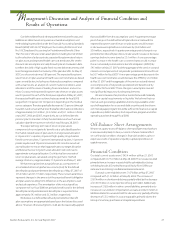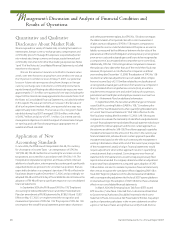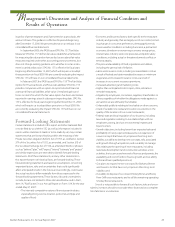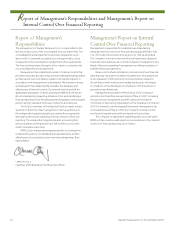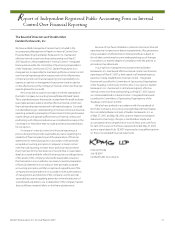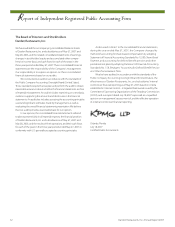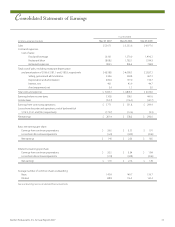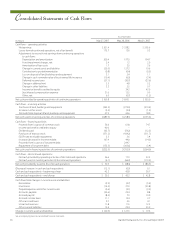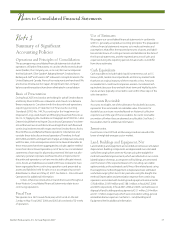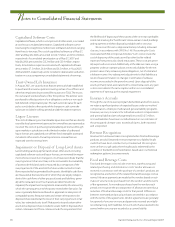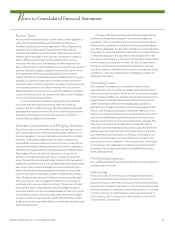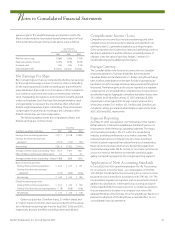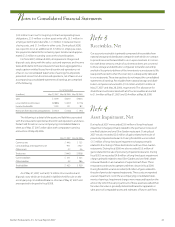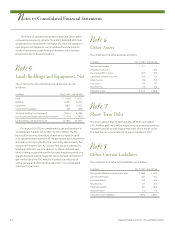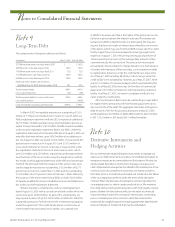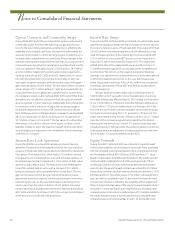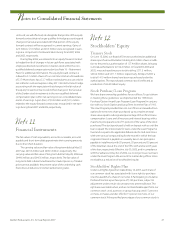Red Lobster 2007 Annual Report Download - page 39
Download and view the complete annual report
Please find page 39 of the 2007 Red Lobster annual report below. You can navigate through the pages in the report by either clicking on the pages listed below, or by using the keyword search tool below to find specific information within the annual report.
Darden Restaurants, Inc. Annual Report 2007 37
Notes to Consolidated Financial Statements
Note1
Summary of Significant
Accounting Policies
Operations and Principles of Consolidation
The accompanying consolidated financial statements include the
operations of Darden Restaurants, Inc. and its wholly owned subsid-
iaries (Darden, the Company, we, us or our). We own and operate
the Red Lobster®, Olive Garden®, Bahama Breeze®, Smokey Bones
Barbeque & Grill® and Seasons 52® restaurant concepts located in the
United States and Canada. None of our restaurants are franchised. We
also license 43 restaurants in Japan. All significant inter-company
balances and transactions have been eliminated in consolidation.
Basis of Presentation
During fiscal 2007, we closed or are holding for sale all Smokey Bones
and Rocky River Grillhouse restaurants and closed nine Bahama
Breeze restaurants. Consistent with the discontinued operations
reporting provisions of Statement of Financial Accounting
Standards (SFAS) No. 144, “Accounting for the Impairment or
Disposal of Long-Lived Assets” and Emerging Issues Task Force Issue
No. 03-13, “Applying the Conditions in Paragraph 42 of SFAS No. 144 in
Determining Whether to Report Discontinued Operations,” we deter-
mined that we have or will discontinue all significant cash flows and
continuing involvement with respect to these Smokey Bones, Rocky
River Grillhouse and Bahama Breeze operations noted above and
consider these to be discontinued operations. Therefore, for fiscal
2007, 2006 and 2005, all impairment charges and disposal costs, along
with the sales, costs and expenses and income taxes attributable to
these restaurants have been aggregated to a single caption entitled
losses from discontinued operations, net of tax on our consolidated
statements of earnings for all periods presented. We have not allo-
cated any general corporate overhead to amounts presented in
discontinued operations, nor have we elected to allocate interest
costs. Assets and liabilities associated with these restaurants have
been segregated from continuing operations and presented as
assets and liabilities held for sale on our accompanying consoli-
dated balance sheet as of May 27, 2007. See Note 2 – Discontinued
Operations for additional information.
Unless otherwise noted, amounts and disclosures throughout
these Notes to Consolidated Financial Statements relate to our
continuing operations.
Fiscal Year
We operate on a 52/53 week fiscal year, which ends on the last
Sunday in May. Fiscal 2007, 2006 and 2005 all consisted of 52 weeks
of operation.
Use of Estimates
We prepare our consolidated financial statements in conformity
with U.S. generally accepted accounting principles. The preparation
of these financial statements requires us to make estimates and
assumptions that affect the reported amounts of assets and liabili-
ties and disclosure of contingent assets and liabilities at the date of
the financial statements, and the reported amounts of sales and
expenses during the reporting period. Actual results could differ
from those estimates.
Cash Equivalents
Cash equivalents include highly liquid investments such as U.S.
treasury bills, taxable municipal bonds and money market funds
that have an original maturity of three months or less. Amounts
receivable from credit card companies are also considered cash
equivalents because they are both short-term and highly liquid in
nature and are typically converted to cash within three days of the
sales transaction.
Accounts Receivable
Accounts receivable, net of the allowance for doubtful accounts,
represents their estimated net realizable value. Provisions for
doubtful accounts are recorded based on historical collection
experience and the age of the receivables. Accounts receivable
are written off when they are deemed uncollectible. See Note 3 –
Receivables, Net for additional information.
Inventories
Inventories consist of food and beverages and are valued at the
lower of weighted-average cost or market.
Land, Buildings and Equipment, Net
Land, buildings and equipment are recorded at cost less accumulated
depreciation. Building components are depreciated over estimated
useful lives ranging from seven to 40 years using the straight-line
method. Leasehold improvements, which are reflected on our consol-
idated balance sheets as a component of buildings, are amortized
over the lesser of the expected lease term, including cancelable
option periods, or the estimated useful lives of the related assets using
the straight-line method. Equipment is depreciated over estimated
useful lives ranging from two to ten years also using the straight-line
method. Depreciation and amortization expense from continuing
operations associated with buildings and equipment amounted to
$192.8 million, $189.9 million and $188.1 million, in fiscal 2007, 2006
and 2005, respectively. In fiscal 2007, 2006 and 2005, we had losses on
disposal of land, buildings and equipment of $3.1 million, $2.4 million
and $1.1 million, respectively, which were included in selling, general
and administrative expenses. See Note 5 – Land, Buildings and
Equipment, Net for additional information.
C


